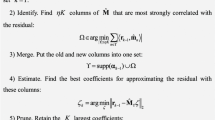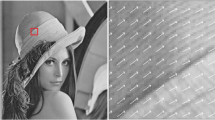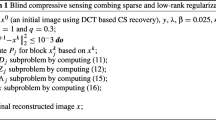Abstract
Image reconstruction from under-sampled data had always been challenging due to its implicit ill-posed nature until, that is, the emergence of compressed sensing. This paper proposes a new compressed sensing-based model and an efficient algorithm for image reconstruction from sparse observations, based upon a generalized multiple sparse restrictions framework to describe both local similarities and nonlocal similarities at the regularization stage. An efficient split Bregman method is employed to decouple the nonlinear optimization problem in order to iteratively approach the optimum solution. To obtain better restoration for multiband images, a principle component analysis is suggested to improve the signal-to-noise ratio of auxiliary parameters, and the noise variance in the wavelet domain is calculated adaptively. A comparison between filters showed that eight 3×3 sized filters learned from the model of fields of experts are by far the best filters to earn high peak signal-to-noise ratio. The proposed split Bregman optimization compressed sensing algorithm with fields of experts trained filters is compared to alternative methods such as Orthogonal Matching Pursuit, Compressive Sampling Matching Pursuit, Group-based Sparse Representation, and Compressive Sensing based on Bregman Split and principal component analysis. The experimental results of nine images show that the new method has competitive results for single-band images and outweighs all the other methods for color images, and so it is an appropriate model for reconstructing multichannel images.


Similar content being viewed by others
References
Alparone, L., Baronti, S., Garzelli, A., & Nencini, F. (2004). A global quality measurement of pan-sharpened multispectral imagery. IEEE Geoscience and Remote Sensing Letters, 1(4), 313–317.
Dong, W., Shi, G., & Li, X. (2013). Nonlocal image restoration with bilateral variance estimation: a low-rank approach. IEEE Transactions on Image Processing, 22(2), 700–711.
Fei, X., Wei, Z., & Xiao, L. (2013). Iterative directional total variation refinement for compressive sensing image reconstruction. IEEE Signal Processing Letters, 20(11), 1070–1073.
Goldstein, T., & Osher, S (2009). The split bregman method for l1-regularized problems. SIAM Journal on Imaging Sciences, 2(2), 323–343.
Liu, P., & Eom, K.B. (2014). Compressive sensing of noisy multispectral images. IEEE Geoscience and Remote Sensing Letters, 11(11), 1931–1935.
Liu, Q., Wang, S., Ying, L., Peng, X., Zhu, Y., & Liang, D. (2013). Adaptive dictionary learning in sparse gradient domain for image recovery. IEEE Transactions on Image Processing, 22(12), 4652–4663.
Ma, S., Yin, W., Zhang, Y., & Chakraborty, A. (2008). An efficient algorithm for compressed mr imaging using total variation and wavelets. In IEEE Conference on Computer Vision and Pattern Recognition, 2008. CVPR 2008 (pp. 1–8) IEEE.
Mairal, J., Bach, F., Ponce, J., & Sapiro, G. (2010). Online learning for matrix factorization and sparse coding. The Journal of Machine Learning Research, 11, 19–60.
Needell, D., & Tropp, J.A. (2009). Cosamp: Iterative signal recovery from incomplete and inaccurate samples. Applied and Computational Harmonic Analysis, 26(3), 301–321.
Ranchin, T., & Wald, L. (2000). Fusion of high spatial and spectral resolution images: the arsis concept and its implementation. Photogrammetric Engineering and Remote Sensing, 66(1), 49–61.
Roth, S., & Black, M.J. (2005). Fields of experts: A framework for learning image priors. In IEEE Computer Society Conference on Computer Vision and Pattern Recognition, 2005. CVPR 2005, (Vol. 2 pp. 860–867) IEEE.
Roth, S., & Black, M.J. (2009). Fields of experts. International Journal of Computer Vision, 82(2), 205–229.
Schmidt, U., Gao, Q., & Roth, S. (2010). A generative perspective on mrfs in low-level vision. In IEEE Conference on Computer Vision and Pattern Recognition (CVPR), 2010 (pp. 1751–1758) IEEE.
Tropp, J.A., & Gilbert, A.C. (2007). Signal recovery from random measurements via orthogonal matching pursuit. IEEE Transactions on Information Theory, 53(12), 4655–4666.
Wang, Z., & Bovik, A.C. (2002). A universal image quality index. IEEE Signal Processing Letters, 9(3), 81–84.
Zhang, J., Zhao, D., & Gao,W. (2014). Group-based sparse representation for image restoration. Available at arXiv:1405.3351.
Zhang, Y. (2008). Methods for image fusion quality assessment-a review, comparison and analysis. The International Archives of the Photogrammetry, Remote Sensing and Spatial Information Sciences, 37, 1101–1109.
Zhou, M., Chen, H., Paisley, J., Ren, L., Li, L., Xing, Z., Dunson, D., Sapiro, G., & Carin, L. (2012). Nonparametric bayesian dictionary learning for analysis of noisy and incomplete images. IEEE Transactions on Image Processing, 21(1), 130–144.
Zhu, S.C., Wu, Y., & Mumford, D. (1998). Filters, random fields and maximum entropy (frame): Towards a unified theory for texture modeling. International Journal of Computer Vision, 27(2), 107–126.
Acknowledgments
This work is supported by the National Natural Science Foundation of China (No. 41471368 and No. 41571413).
Author information
Authors and Affiliations
Corresponding author
Rights and permissions
About this article
Cite this article
Wei, J., Huang, Y., Lu, K. et al. Fields of Experts Based Multichannel Compressed Sensing. J Sign Process Syst 86, 111–121 (2017). https://doi.org/10.1007/s11265-015-1065-6
Received:
Revised:
Accepted:
Published:
Issue Date:
DOI: https://doi.org/10.1007/s11265-015-1065-6




